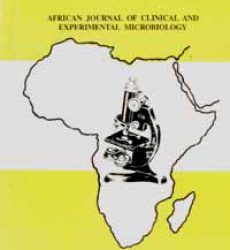1 Guemgne Todjom, F., 1 Makou Tsapi, E., 1 Gamago, G. A., 2 Vignoles, P., 3 Wabo Pone J., and 4* Djuikwo Teukeng, F. F.
1 Evangelical University of Cameroon, BP 127, Bandjoun, Cameroon
2 INSERM U 1094, Tropical Neuroepidemiology, Institute of Neuroepidemiology and Tropical Neurology, 2, rue du Docteur Raymond Marcland, 87025 Limoges, France
3 Research Unit of Biology and Applied Ecology, Faculty of Science, BP 067, Dschang, Cameroon
4 Faculty of Health Sciences, Université des Montagnes, BP 208, Bangangté, Cameroon
*Correspondence to: Dr. F. F. Djuikwo Teukeng (ffnouboue@yahoo.fr)
Abstract:
Background: Toxoplasmosis is a common worldwide infection caused by the protozoan Toxoplasma gondii. In Cameroon, several recent studies have reported high seroprevalence of this parasitosis in various hospitals (Douala, Limbe, Njinikom and Yaoundé). The aim of this study was to determine whether this high prevalence of toxoplasmosis might occur in other regions of the country.
Methodology: Serological tests by the indirect Enzyme Linked Immunosorbent Assay (ELISA) for IgG and IgM were carried out on 200 pregnant women (36 HIV-positive and 164 HIV-negative) at the Protestant Hospital of Mbouo-Bandjoun in western Cameroon to determine the presence of Toxoplasma gondii infection and to identify the risk factors associated with seropositivity of the subjects.
Results: The overall seroprevalence of anti-Toxoplasma antibodies was 45.5%. The prevalence rate was 80.5% in the HIV-positive group (47.2% IgG, 22.2% IgM and 11.1% IgG + IgM) and 37.8% in the HIV-negative group (25.6%, 9.7% and 2.4% respectively). Using a multivariate logistic regression analysis, the secondary level of educational, presence of HIV infection, and frequency of close contacts with cats were significantly associated with the prevalence of IgG and/or IgM antibodies.
Conclusion: Compared with previous reports of human toxoplasmosis in Cameroon, the prevalence in our study showed a decrease in the disease occurrence. Further studies are needed to determine whether this decrease is localised to our study or a general phenomenon currently affecting the country.
Keywords: Cameroon, IgG, IgM, pregnant women, seroprevalence, Toxoplasma gondii
Received January 9, 2019; Revised May 6, 2019; Accepted May 7, 2019
Copyright 2019 AJCEM Open Access. This article is licensed and distributed under the terms of the Creative Commons Attrition 4.0 International License (http://creativecommmons.org/licenses/by/4.0), which permits unrestricted use, distribution and reproduction in any medium, provided credit is given to the original author(s) and the source.
Séroprévalence de la toxoplasmose et facteurs de risque associés chez des femmes enceintes à l’Hôpital Protestant de Mbouo-Bandjoun, Cameroun
1 Guemgne Todjom, F., 1 Makou Tsapi, E., 1 Gamago, G. A., 2 Vignoles, P., 3 Wabo Pone J., and 4* Djuikwo Teukeng, F. F.
1 Université évangélique du Cameroun, BP 127, Bandjoun, Cameroun
2 INSERM U 1094, Neuroépidémiologie tropicale, Institut de neuroépidémiologie et de neurologie tropicale, 2, rue du Docteur Raymond Marcland, 87025 Limoges, France
3 Unité de recherche en biologie et écologie appliquée, Faculté des sciences, BP 067, Dschang, Cameroun
4 Faculté des sciences de la santé, Université des Montagnes, BP 208, Bangangté, Cameroun *Correspondance à: Dr. F. F. Djuikwo Teukeng (ffnouboue@yahoo.fr)
Résumé:
Contexte: La toxoplasmose est une infection répandue dans le monde entier et causée par le protozoaire Toxoplasma gondii. Au Cameroun, plusieurs études récentes ont signalé une forte séroprévalence de la parasitose dans divers hôpitaux (Douala, Limbé, Njinikom et Yaoundé). Le but de cette étude était de déterminer si cette forte prévalence de la toxoplasmose pouvait se produire dans d’autres régions du pays.
Méthodologie: Des tests sérologiques pour quantifier les IgG et IgM par dosage indirect immuno-enzymatique indirect selon la méthode ELISA ont été effectués sur 200 femmes enceintes (36 VIH-positives et 164 VIH-négatives) à l’hôpital protestant de Mbouo-Bandjoun, dans l’ouest du Cameroun, afin de déterminer la présence d’infectiona à T. gondii et d’identifier les facteurs de risque associés à la séropositivité des sujets.
Résultats: La séroprévalence globale des anticorps anti-Toxoplasma était de 45,5 %. Le taux de prévalence était de 80,5 % dans le groupe VIH-positif (47,2 % IgG, 22,2 % IgM et 11,1 % IgG + IgM) et de 37,8 % dans le groupe VIH négatif (25,6 %, 9,7 % et 2,4 %, respectivement). L’emploi d’une analyse de régression logistique multivariée a montré que le niveau secondaire d’éducation, la présence d’une infection par le VIH et la fréquence des contacts étroits avec les chats étaient significativement associés à la prévalence des anticorps IgG et/ou IgM.
Conclusion: Par rapport aux rapports précédents sur la toxoplasmose humaine au Cameroun, la prévalence dans notre étude a montré une diminution de la fréquence de la maladie. Des études complémentaires sont nécessaires pour déterminer si cette baisse est localisée dans notre étude ou est un phénomène général qui affecte actuellement le pays.
Mots clés : Cameroun, femmes enceintes, IgG, IgM, séroprévalence, Toxoplasma gondii
Download full journal in PDF below

